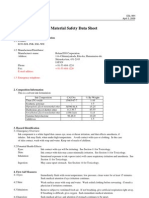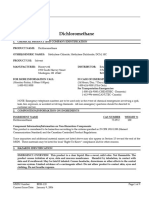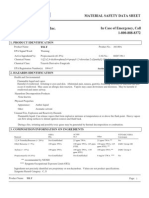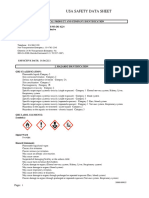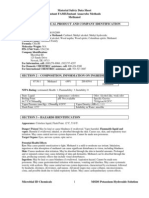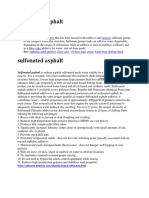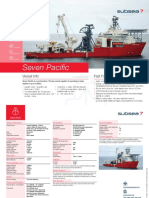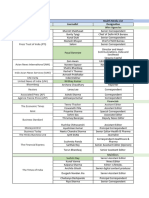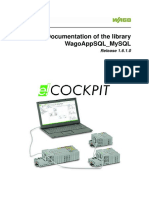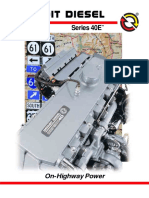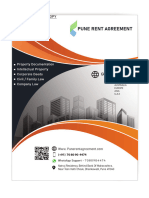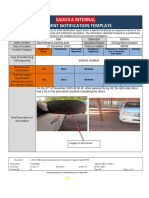MSDS Etanol
MSDS Etanol
Uploaded by
wynneralphCopyright:
Available Formats
MSDS Etanol
MSDS Etanol
Uploaded by
wynneralphOriginal Description:
Original Title
Copyright
Available Formats
Share this document
Did you find this document useful?
Is this content inappropriate?
Copyright:
Available Formats
MSDS Etanol
MSDS Etanol
Uploaded by
wynneralphCopyright:
Available Formats
MATERIALS SAFETY DATA SHEET
(MSDS)
Ethanol (C2H5OH)
MSDS Number
NCP/P/1
Version number
Version 2.0
Date issued
3rd May 2012
Next Review date
May 2014
Page No.
Page 1 of 9
COMPANY DETAILS
Name
Address :
NCP Alcohols
Emergency telephone No.:
+27 (31) 579 2004
121 Sea Cow lake Road, Durban, 4001, South Africa
Telephone
+27 (31) 560 1111
Fax
+27 (31) 579 2776
1. Product and Company Identification
(Page 1 may be used as an emergency safety data sheet)
Trade name
: Ethanol (Industrial, Absolute or Anhydrous,
Rum, Light Spirits, Extra Neutral Potable,
Neutral Potable, Rectified Extra Neutral and
High Purity Extra Neutral Potable Alcohol)
Chemical abstract No.
: 64-17-5
Molecular Mass
: 46,08
Chemical family
: Aliphatic Alcohol
NIOSH No.
: KQ 6300000
Chemical name
: Ethanol
Hazchem code
: 2(S) E; 3(S) E
Synonyms
: Ethyl Alcohol, See Trade name
UN No.
: 1170
2. Composition:
v
Hazardous components
: Ethyl Alcohol (75.0 99.9% /v)
EEC classification
: 200 578 6 30
R Phrases
: R11 (Highly Flammable)
3. Hazards Identification:
Main Hazard
: Harmful if swallowed or inhaled. Possible aspiration hazard if swallowed (can enter lungs and cause
damage). May be irritating to the skin, eyes and respiratory tract. Over exposure may cause CNS depression.
Possible reproductive hazard.
Flammability
: Flash Point 12:C. Extremely flammable liquid (R11). Ignition temperature 425:C.
Chemical Hazard
: Ethanol is a flammable liquid whose vapours can form ignitable and explosive mixtures with air at normal
room temperatures. Thus, an aqueous mixture containing 30% ethanol can produce a flammable mixture of
1
vapour and air at 29:C, and even one containing only 5% alcohol can produce a flammable mixture at 62:C.
2
Ethanol reacts vigorously with a wide range of oxidizing materials and other chemicals .e.g. Disulphuryl
Difluoride, Silver Nitrate, Bromine Pentafluoride, Potassium Perchlorate, Nitrosyl Perchlorate, Chromyl
Chloride, Chloryl Perchloride, Uranyl Perchlorite, Chromium Trioxide, Fluorine Nitrate, Dioxygen Difluoride,
Uranium Hexafluoride, Iodine Heptafluoride, Tetrachlorosilane, Permanganic acid, Nitric acid [the nitric acid
3,5
fizz reaction used formally for cleaning laboratory glassware should not be used ], Hydrogen Peroxide,
Peroxodisulphuric acid, Potassium Dioxide, Sodium Peroxide, Potassium Permanganate, Ruthenium (VIII)
6
7
Oxide, Platinum, Potassium , Potassium tert Butoxide, Silver Oxide and Sodium .
MATERIALS SAFETY DATA SHEET
(MSDS)
Ethanol (C2H5OH)
MSDS Number
NCP/P/1
Version number
Version 2.0
Date issued
3rd May 2012
Next Review date
May 2014
Page No.
Page 2 of 9
Biological Hazard
: Ethanol is rapidly oxidized in the body to acetaldehyde, then to acetate, and finally to carbon dioxide and
8, 9
water; un-oxidized alcohol is excreted in the urine and expired in the air.
Reproductive hazard
: Some evidence of foetotoxicity
and teratogenicity has been observed in experimental animals
treated with high doses of ethanol during gestation. Alcohol may induce spontaneous abortions, may impair
fertility, may cause harm to the unborn child and may cause harm to breast fed babies. The reproductive
hazards have been determined after repeated excessive consumption of ethanol; these effects are not likely
to occur through exposure below the Occupational Exposure Limits in the working environment.
Health effects eyes
: Moderately irritating. Exposure to liquid, vapours, fumes or mist may cause irritation. Direct contact may
cause irritation, redness, pain, corneal inflammation and possible corneal damage.
Health effects skin
: Repeated or prolonged contact may result in defatting, redness, pain, itching, inflammation, cracking and
possible secondary infection. Repeated skin contact may result in allergic skin reaction in a very small
proportion of individuals.
Health effects ingestion
: Large doses lead to alcohol poisoning while repeated ingestion can lead to alcoholism. Alcohol abuse and
11-13
dependence can have a profound effect on work performance and tendency to accidents at work.
The
presence of denaturants, e.g. Methanol, pyridines, and benzene in industrial alcohol greatly increase the
toxicity on ingestion. Ethanol drinking is also suspected of increasing the toxic effect of other chemicals
14
encountered in the laboratory and the workplace by inhibition of their metabolism or excretion ; e.g. 1, 1, 1
15
16
17
18, 19
Trichloroethane , Xylene, Trichloroethylene and Dimethylformamide , Benzene and Lead.
May
cause harmful central nervous system effects. Effects may include excitation, euphoria, headache, dizziness,
drowsiness, blurred vision, fatigue, tremors, convulsions, loss of consciousness, coma, respiratory arrest and
death. Severe acute intoxication may cause Hypoglycaemia, Hypothermia and extensor rigidity. Prolonged or
frequent contact may result in liver injury.
Health effects inhalation
: Intoxicating if continuously inhaled for a long period of time. Occupational Exposure Limits (8-hour reference
3 30
period) 1000ppm (1900mg/m ).
Carcinogenicity
: Long-term consumption of alcoholic beverages demonstrates an increase in the occurrence of breast cancer and
colorectal cancer. Malignant tumours of the oral cavity, Pharynx, Larynx, Oesophagus and Liver is also causally
31
20, 21
related to the consumption of alcoholic beverages. Some studies
have shown an excess incidence of
laryngeal cancer over the expected from exposure to synthetic alcohol, with Diethyl Sulphate probably being the
causative agent.
Mutagenicity
: Ethanol has been found to be non- mutagenic in the Salmonella microsome test, but some transient
23-25
mutagenic changes have been observed in male, but not female, mice treated with rather large doses.
Ethanol is mutagenic in man via its first metabolite, Acetaldehyde. Acetaldehyde induces chromosomal
32
aberrations, sister-chromatid exchanges and cross-links between DNA strands.
Neurotoxicity
26-28
29
22
: Over exposure may cause Central Nervous System (CNS) depression.
4. First aid Measures:
Product in eye
: Flush immediately with water or neutral saline solution for at least 15 minutes. Seek medical attention.
Product on skin
: Remove contaminated clothing and rinse contaminated area with soap and water. If skin irritation persists
seek medical attention.
MATERIALS SAFETY DATA SHEET
(MSDS)
Ethanol (C2H5OH)
MSDS Number
NCP/P/1
Version number
Version 2.0
Date issued
3rd May 2012
Next Review date
May 2014
Page No.
Page 3 of 9
Product ingested
: If victim is conscious, give 1-3 glasses of water or milk to dilute stomach contents. If spontaneous vomiting
occurs, or when vomiting is induced, monitor for breathing difficulty. Do not make an unconscious or semi
conscious person vomit. Keep affected person warm at rest. Get medical attention for substantial ingestions
and/or gastrointestinal symptoms.
Product inhaled
: Remove the victim to fresh air. If not breathing, ensure open airway and institute cardiopulmonary
resuscitation (CPR). If breathing is weak, irregular or has stopped apply artificial respiration. Oxygen may be
beneficial. Keep affected person warm and at rest. Get immediate medical attention.
5. Fire fighting Measures:
Extinguishing media
: Use dry chemical, alcohol foam or carbon dioxide to extinguish fire. Water may be ineffective but should be
used to cool fire- exposed containers, structures and to protect personnel. If leak or spill has not ignited,
ventilate area and use water spray to disperse gas or vapour and to protect personnel attempting to stop a
leak. Use water to dilute spills and to flush them away from sources of ignition. Do not flush down public
sewers or other drainage systems.
Special hazards
: Flammable
Flash point
: 12 - 16:C
v
Flammability/explosion limits
: 3, 3 19% /v
Dangerous when exposed to heat or flame. Vapours form flammable or explosive mixtures with air at room
temperature. Vapour or gas may spread to distant ignition sources and flash back. Run off to sewer may
cause fire or explosion hazard. Containers may explode in heat of fire. Vapours may concentrate in confined
areas. Irritating or toxic substances may be emitted upon thermal decomposition.
Protective clothing
: Exposed fire fighters should wear approved self-contained breathing apparatus with full face mask and full
protective equipment.
6. Accidental Release Measures:
Personal precautions
: Protective clothing should be worn to prevent excessive skin contact.
Environmental precautions
: Prevent liquid entering sewers. Do not allow to enter surface waters, storm drains, etc.
Small spills
: Take immediate steps to stop and contain the spill. Caution should be excised regarding personnel safety
and exposure to be spilled material. Eliminate all sources of ignition and wear protective clothing. Absorb
small spills onto paper towels and evaporate in a safe place e.g. in a fume hood. Flush the contaminated area
with plenty of water.
Large spills
: Stop leak if you can do it without risk. Contact your local fire department. Eliminate all sources of ignition and
static; restrict access to area until completion of clean-up procedure. Wear adequate protective equipment,
use self-contained breathing apparatus in confined poorly-ventilated areas. Large quantities should be
absorbed on to sand, vermiculite or an equivalent absorbent material and removed to a safe area for
disposal. Flush the contaminated area with plenty of water. Incineration is the recommended method of
disposal.
MATERIALS SAFETY DATA SHEET
(MSDS)
Ethanol (C2H5OH)
MSDS Number
NCP/P/1
Version number
Version 2.0
Date issued
3rd May 2012
Next Review date
May 2014
Page No.
Page 4 of 9
7. Handling and Storage:
Suitable material
Handling/
storage precautions
: Ethanol is not corrosive to metals and may be stored in stainless steel, mild steel or aluminium containers.
Ethanol may also be stored in HDPE containers.
: Ground lines and equipment used during transfer to reduce the possibility of static spark-initiated fire or
explosion. Store in approved flammable liquid storage containers. Keep containers tightly closed as this
material readily absorbs moisture. Store away from incompatible materials. Store in a cool, dry wellventilated area away from sparks, flames and other sources of ignition. Eliminate all sources of static
electricity. Use non sparking electrical and ventilation systems. Storage criteria: Flammable Liquid store
8. Exposure Control / Personal Protection:
Occupational
exposure limits
:
Country
Engineering
control measures
Personal protection
respiratory
Personal protection
hand
Personal protection
eye
Personal protection
skin
Other protection
8 Hour TWA Hygiene Limit
US (OSHA)
US (ACGIH)
Germany (MAK)*
UK (OES)
Slovak Republic
1900 mg/m (1000ppm)
1900 mg/m (1000ppm)
960 mg/m3 (500ppm)
1920 mg/m (1000ppm)
960 mg/m3 (500ppm)
Czech Republic
1000 mg/m
STEL
None
None
Peak limit cat. II,1
None
1920 mg/m3 (1000ppm)
(30 min, 4x per shift)
3000 mg/m
: Engineering control methods to reduce hazardous exposures are preferred. General methods include
mechanical ventilation (dilution and local exhaust), process or personnel enclosure, control of process
conditions and process modification (e.g. substitution of a less hazardous material). Administrative controls
and personal protective equipment may also be required. Use a non-sparking, grounded ventilation system
separate from other exhaust ventilation systems. Exhaust directly to the outside. Supply sufficient
replacement air to make up for air removed by exhaust system.
: If exposure limits are exceeded or if irritation is experienced, an approved respirator for organic vapours is
generally acceptable. For high concentrations and for oxygen-deficient atmospheres, use approved airsupplied respirator. Full respiratory protection should be readily available in case of spillage.
: Rubber (Butyl) or neoprene gloves are recommended.
: Prevent eye contact with this material. Wear chemical tight safety goggles where eye exposure is
reasonably probable. Provide an eyewash station immediately accessible to the work area. Contact lenses
should not be worn when working with this chemical.
: Avoid skin contact. When working with this substance, wear appropriate chemical protective gloves.
Depending upon conditions of use, additional protection may be necessary such as face shield, apron, etc.
: Provide a safety shower immediately accessible to the work area.
MATERIALS SAFETY DATA SHEET
(MSDS)
Ethanol (C2H5OH)
MSDS Number
NCP/P/1
Version number
Version 2.0
Date issued
3rd May 2012
Next Review date
May 2014
Page No.
Page 5 of 9
9. Physical and Chemical Properties:
Appearance
: Colourless, volatile liquid
Odour
: Characteristic pleasant odour
pH
: Neutral
Boiling point
: 78.2:C - 78.5:C
Melting point
: - 130:C to - 112:C
Flash point
: 12:C - 16:C
Flammability
: 3, 3 19% v/v
Auto-flammability
: 363:C
Explosive properties
: Vapours can form explosive mixtures with air. All sources of ignition or static must be excluded.
Oxidizing properties
: None
Vapour pressure
: 59 mm Hg at 20:C
Density
: 785.3 kg/m 809 kg/m at 25:C
Solubility water
: Miscible with water in all proportions
Solubility solvent
: Miscible with ether, methanol, chloroform and acetone
Solubility coefficient
: 1100 @ 37:C
33
10. Stability and Reactivity:
Condition to avoid
: Overheating, flames, sources of ignition or static electricity. Oxidizing agents. Vapour/ air mixtures are
explosive.
Incompatible materials
: See section 3 (chemical hazards).
Hazardous decomposition products: Incomplete combustion can generate carbon monoxide and carbon dioxide.
MATERIALS SAFETY DATA SHEET
(MSDS)
Ethanol (C2H5OH)
MSDS Number
NCP/P/1
Version number
Version 2.0
Date issued
3rd May 2012
Next Review date
May 2014
Page No.
Page 6 of 9
11. Toxicological Information:
Acute toxicity
Short-term hazards
Acute oral toxicity Ethanol
Acute inhalation toxicity Ethanol
Acute dermal toxicity Ethanol
: LD50 rat: 7,060 mg/kg; literature value
: LC50 rat: 66,000 mg/l; literature value; 4 h
: LDLo rabbit: 20,000 mg/kg; literature value
NOAEL - 2400 mg/kg (2%) - for rats
LOAEL 3600 mg/kg (3%) - for rats
Skin and eye contact
Redness, pain (refer to Section 3 for further information)
Chronic toxicity
Refer to Section 3
Carcinogenicity
Refer to Section 3
Mutagenicity
Refer to Section 3
Neurotoxicity
Refer to Section 3
Reproductive hazards
Refer to Section 3
12. Ecological Information:
Aquatic toxicity fish
In high concentration it harms fish and plankton; LC50 (fish, 96 hours) 15.3 mg/L (Pimephales
promelas)
Aquatic toxicity daphnia
Threshold for deleterious effects in small crustaceans upwards of 7.800 mg/l;
EC50 (Daphnia, 48 hours) 5012 mg/L (Ceriodaphnia dubia)
Aquatic toxicity algae
Toxic threshold concentration: Pseudomonas putida upwards of 6.500mg/l, Scenedesmus
quadricauda upwards of 5.000mg/l, Microsystis aeruginosa upwards of 1.450ml/L
IC50 (algae, 72 hours) 275 mg/L
Biodegradability
This product is readily biodegradable. Ethanol is widely recognized as being readily biodegradable in
the environment as it is both a metabolite of and nutrient for microbes. There are no persistent
Bio accumulation
This product in not expected to bio accumulate through the food chains in the environment. The
very low log KOW of 0.31 is indicative of a low bioaccumulation potential.
Mobility
This product is likely to volatize rapidly into the air because of its high vapour pressure. The product
is poorly absorbed onto soils or sediments. Adsorption coefficient (KOC) solid phase/liquid phase = 1
(highly mobile)
German wgk
1 (low hazard to water)
MATERIALS SAFETY DATA SHEET
(MSDS)
Ethanol (C2H5OH)
MSDS Number
NCP/P/1
Version number
Version 2.0
Date issued
3rd May 2012
Next Review date
May 2014
Page No.
Page 7 of 9
13. Disposal Considerations:
Disposal methods
: Only under conditions approved by local authorization. See also Section 6.
Disposal of packaging
: Empty containers may contain flammable and hazardous residues. Always obey hazard warnings.
14. Transport Information:
UN No
: 1170
Substance Identity No
: UN 1170
ADR/RID class
: 3
ADR/RID item No
: 3(b)
ADR/RID hazard identity No : 3
IMDG shipping name
: Ethanol
IMDG class
: 3.2
IMDG packaging group
: II
IMDG marine pollutant
: Not a marine pollutant
IMDG EMS No
: F-E, S-D
IMDG MFAG table No
: 3074
IATA shipping name
: Ethanol Solutions
IATA class
: 3
IATA subsidiary risk(s)
: Flammable liquid
ADNR class
: UN No.:1170; Class 3, Packaging Group II
UK description
: Not available
UK- emergency action class : Not available
UK classification
: Not available
Tremcard No
: 1170
MATERIALS SAFETY DATA SHEET
(MSDS)
Ethanol (C2H5OH)
MSDS Number
NCP/P/1
Version number
Version 2.0
Date issued
3rd May 2012
Next Review date
May 2014
Page No.
Page 8 of 9
15. Regulatory Information:
EEC hazard classification
200 578 - 6
Risk phases
R11
Safety phases
S2 - Keep out of the reach of children
S7 - Keep container tightly closed
S9 - Keep container in a well ventilated place
S16 - Keep away from source of ignition
S33 - Take precautionary measures against static discharge.
National legislation
Hazardous Substances Act 15 of 1973 and Regulations
Occupational Health and Safety Act 85 of 1993 (Hazardous Chemical Substances Regulations)
16. Sources of Information
1.
2.
3.
Chemical Safety Data Sheets Volume 1 - Royal Society of Chemistry Information Services (Numbers in parenthesis refer to this article,
see below).
Hazardous Chemicals Data Book, Environmental Health Review No. 4 Edited by G. Weiss.
Canadian Centre for Occupational Health and Safety. Record No. 516022
17. Other Information
1.
2.
The information above is believed to be accurate and represents the best information currently available to us. However, we make
no warranty of merchantability or any other warranty, express or implied, with respect to such information, and we assume no
liability resulting from its use. Users should make their own investigations to determine the suitability of the information for their
particular purposes. In no event shall NCP Alcohols be liable for any claims, losses, or damages of any third party or for lost profits or
any special, indirect, incidental, consequential or exemplary damages, howsoever arising, even if NCP Alcohols has been advised of
the possibility of such damages.
v
This product may be denatured upon request with small quantities ( 5% /v)of one or more of the following denaturants: Menthol,
Denatonium Benzoate (Bitrix), Propylene Glycol, Iso-propyl alcohol, Methanol, Wood Naphtha, Di-ethyl Pthalate (DEP), Hibatane or
Butanol or formulations as per the Specilaised Denaturants list in the Industrial Solvents handbook.
MATERIALS SAFETY DATA SHEET
(MSDS)
Ethanol (C2H5OH)
MSDS Number
NCP/P/1
Version number
Version 2.0
Date issued
3rd May 2012
Next Review date
May 2014
Page No.
Page 9 of 9
18. References
1.
2.
3.
4.
5.
6.
7.
8.
9.
10.
11.
12.
13.
14.
15.
16.
17.
18.
19.
20.
21.
22.
23.
24.
25.
26.
27.
28.
29.
30.
31.
Chem. Saf. Summ. 1984, 55(219), 62
Bretherick,L.Handbook of Reactive Chemical Hazards (3rd edition)
Univ. Saf. Assocn. Saf. News 1982, (16)
Laboratory Hazards Bulletin 1982, 584
Laboratory Hazards Bulletin 1983, 113
Pratt, E.F.; et al. J. Am. Chem. Soc. 1954, 75, 54
Braendstrom, A. Acta Chem. Scand. 1951, 4, 1608-1010
Wimer, W.W.; et al. Alcohols Toxicology (Noyes Data, 1983)
Henson, E.V. JOM, J. Occup. Med. 1960, 2, 497
Lester, D.; Greenberg, L.A. J. Stud. Alcohol. 1951, 12, 167
Encyclopedia of Occupational Health & Safety ILO. Ethyl Alcohol and Alcoholism
Emery, M. Occup. Saf. Health 1979, 9(9), 8-13
Madden, J.S. J. Soc. Occup. Med. 1976, 26(2), 61-64
Christensen, J.M. Acta, Pharmacol. Toxicol. 1983, 53, Suppl. II
Woolverton, W.L.; Balster, R.L. Toxicol. Appl. Pharmacol. 1981, 59(1), 1-7
Riihimaki, V.; et al. Scand. J. Work, Environ. Health 1982, 8(1), 77-79
Baarson, K.A.; et al. Toxicol. Appl. Pharmacol. 1982, 64(3), 393-404
Munoz, P.J.; et al. Rev. Med. 1984, 22(2), 79-83
Ito, Y.; et al. J. Sci. Labour 1984, 60(6), 255-267
Lynch, J.; et al. JOM, J. Occup. Med. 1979, 21(5), 333-341
Tuyns, A.J.; at al. Int. J. Cancer 1979, 23(4), 443-447
McCann, J.; et al. Proc. Natl. Acad. Sci. 1975, 72(12), 5135
Badr, F.M.; R.S. Nature 1975, 253, 134
Machemer, L.; D. Mutat. Res. 1975, 29, 209
Chaubey, R.C.; et al. Mutat. Res. 1977, 43, 441
Tze, W.J.; Lee, M. Nature 1975, 257, 479
Skosyreva, A.M. Akush. Ginekol. 1973, 4, 15
Schwetz, B.A.; et al. Teratology 1978, 18(3), 385
Hemminki, K.; Viriei, P. Teratog. Carcinog. Mutagen. 1985, 5(4), 251-318
www_static.shell.com/ethanol_CAS_64_1_5_gb_stl1:pdf
International Agency for Research on Cancer, World Health Organization. (1988). Alcohol drinking. Lyon: World Health Organization,
International Agency for Research on Cancer. ISBN 92-832-1244-4. http://monographs.iarc.fr/ENG/Monographs/vol44/volume44.pdf. p8
32. www.inchem.org/documents/sids/sids/64175.pdf
33. Toxicity and risks induced by Occupational Exposure to chemical compounds Pg.259.
Compiled By: D.D. Liebenberg
Reviewed and updated by: L. Mudaly (SHEQ Manager)
Approved By: G. Bregovits
You might also like
- Handbook of Microbiological Criteria for FoodsFrom EverandHandbook of Microbiological Criteria for FoodsNo ratings yet
- Materials Safety Data Sheet (MSD S) : C O M PA N Y DE T AI L SDocument10 pagesMaterials Safety Data Sheet (MSD S) : C O M PA N Y DE T AI L SEndratRaharjoNo ratings yet
- Material Safety Data Sheet: ProductDocument12 pagesMaterial Safety Data Sheet: ProductOmar EzzatNo ratings yet
- Msds FenolDocument6 pagesMsds Fenolbenol1987No ratings yet
- Phenol MSDS: Section 1: Chemical Product and Company IdentificationDocument6 pagesPhenol MSDS: Section 1: Chemical Product and Company IdentificationShabrina Aufar SalmaNo ratings yet
- Msds MFG 4141 - MoldReleaseConctrtDocument3 pagesMsds MFG 4141 - MoldReleaseConctrtJean ValjeanNo ratings yet
- Material Safety Data Sheet Toluene MSDS Number: M1003 Effective Date: 9/07/2004Document4 pagesMaterial Safety Data Sheet Toluene MSDS Number: M1003 Effective Date: 9/07/2004junglefish71No ratings yet
- Material Safety Data Sheet: 1. Chemical Product and Company IdentificationDocument5 pagesMaterial Safety Data Sheet: 1. Chemical Product and Company IdentificationEdgar Julio Sara TairoNo ratings yet
- Derv MSDSDocument6 pagesDerv MSDSUgonnaNo ratings yet
- MSDS Rum 60%Document3 pagesMSDS Rum 60%Hugo MarticorenaNo ratings yet
- MSDS Esl-WhDocument4 pagesMSDS Esl-WhankitleedsNo ratings yet
- MSDS - CyclohexaneDocument9 pagesMSDS - Cyclohexanesimbua72No ratings yet
- Toxcity PDFDocument5 pagesToxcity PDFMurthyAmirNo ratings yet
- Material Safety Data Sheet: Ingredient Name Cas No. % WT Exposure LimitsDocument8 pagesMaterial Safety Data Sheet: Ingredient Name Cas No. % WT Exposure LimitsaggibudimanNo ratings yet
- Isopropyl Alcohol (2-Propanol) : Safety Data SheetDocument9 pagesIsopropyl Alcohol (2-Propanol) : Safety Data SheetMutia Nurul OctaviaNo ratings yet
- MSDS: Iso-OctenesDocument7 pagesMSDS: Iso-OctenesHeavenL77No ratings yet
- Dowtherm A Heat Transfer Fluid MSDSDocument10 pagesDowtherm A Heat Transfer Fluid MSDSDavid ClarkNo ratings yet
- Actellic 50 EcDocument9 pagesActellic 50 Ecnadi1onlyNo ratings yet
- Usa Safety Data Sheet: LORD Corporation 111 LORD Drive Cary, NC 27511-7923 USADocument7 pagesUsa Safety Data Sheet: LORD Corporation 111 LORD Drive Cary, NC 27511-7923 USAErnesto PadillaNo ratings yet
- DichloromethaneDocument9 pagesDichloromethanelabopancamitraNo ratings yet
- Amsoil Foam CleanerDocument11 pagesAmsoil Foam CleanerDonfp ProdNo ratings yet
- 786 CPVC Cement SDSDocument9 pages786 CPVC Cement SDSeslam sokaNo ratings yet
- Msds KafeinDocument6 pagesMsds KafeinNovia Arinda Pradisty100% (1)
- Material Safety Data Sheet: (Acute and Chronic)Document4 pagesMaterial Safety Data Sheet: (Acute and Chronic)Muhammad Andhika AlfaridziNo ratings yet
- Oleum EnglishDocument10 pagesOleum Englishhyde2520015754No ratings yet
- Norlube 3030 MSDSDocument5 pagesNorlube 3030 MSDSrenebbNo ratings yet
- 1,4 Butanediol MSDSDocument8 pages1,4 Butanediol MSDSmiyomiyo567850% (2)
- LEAN AMINE (Ucarsol HS 101) : B R C LDocument2 pagesLEAN AMINE (Ucarsol HS 101) : B R C Ltexwan_No ratings yet
- MSDS - Natural Gas CondensatesDocument7 pagesMSDS - Natural Gas CondensatesChad HornNo ratings yet
- BrominDocument7 pagesBrominIchwan Gates SevenfoldismNo ratings yet
- Material Safety Data Sheet: 1. Product Identification TiltDocument6 pagesMaterial Safety Data Sheet: 1. Product Identification TiltJurgen SchirmacherNo ratings yet
- N Spec 120 Cleaner Data SheetDocument11 pagesN Spec 120 Cleaner Data SheetSergio Alejandro Loza EscobarNo ratings yet
- MSDS DCR 008 AnticongelanteDocument8 pagesMSDS DCR 008 AnticongelanteDcr BateasNo ratings yet
- Material Safety Data Sheet: Section 1 X Product and Company IdentificationDocument5 pagesMaterial Safety Data Sheet: Section 1 X Product and Company Identificationomar benounaNo ratings yet
- Formic MsdsDocument6 pagesFormic Msdsapi-263411629No ratings yet
- MSDSDocument7 pagesMSDSmuchamad yasin100% (1)
- MSDS of StyreneDocument10 pagesMSDS of StyreneVenkatramanan SubramaniyanNo ratings yet
- 12.5 Hypo Rho Rite Solution MSDSDocument11 pages12.5 Hypo Rho Rite Solution MSDSmaheenkapadia4612No ratings yet
- CHEMLOK 6224 Safety Data SheetDocument8 pagesCHEMLOK 6224 Safety Data Sheetgino.pontigoNo ratings yet
- SMC Material Safety Data Sheet MethanolDocument9 pagesSMC Material Safety Data Sheet Methanolanand.srajuNo ratings yet
- Valvoline ATF Dexron III MerconDocument10 pagesValvoline ATF Dexron III MerconNyamdavaa KhatanbaatarNo ratings yet
- NALCO® EC9149A: Section 1. Identification of The Substance/Mixture and of The Company/UndertakingDocument14 pagesNALCO® EC9149A: Section 1. Identification of The Substance/Mixture and of The Company/UndertakingDonatas BertasiusNo ratings yet
- DCP MSDSDocument9 pagesDCP MSDSOnesany TecnologiasNo ratings yet
- MSDS MethanolDocument6 pagesMSDS MethanolAzran AzainiNo ratings yet
- Avonite Surfaces Ultra-Bond G - C8411CDocument17 pagesAvonite Surfaces Ultra-Bond G - C8411CaggibudimanNo ratings yet
- Data Sheet - CHEMLOK 6108Document8 pagesData Sheet - CHEMLOK 6108t5j64yydrhNo ratings yet
- SAFETY - Data Sheet For PetrolDocument13 pagesSAFETY - Data Sheet For Petroluday_khandavilliNo ratings yet
- ATI-PAO-Safety Data Sheet in Compliance With RegulationDocument7 pagesATI-PAO-Safety Data Sheet in Compliance With RegulationGochepz Shanz0% (1)
- Isobutanol Basf V 3.0Document8 pagesIsobutanol Basf V 3.0anon_820613666No ratings yet
- Safety Data Sheet: Chevron (Hong Kong) Euro V DieselDocument12 pagesSafety Data Sheet: Chevron (Hong Kong) Euro V DieselKanthan DevanNo ratings yet
- Msds CP4020 000Document4 pagesMsds CP4020 000johnsopranaNo ratings yet
- Mono Ethylene Glycol MEGDocument6 pagesMono Ethylene Glycol MEGtabriz.alizada.engNo ratings yet
- Msds ManganDocument6 pagesMsds ManganLaely N AfidaNo ratings yet
- SDS ARC Ethylene Oxide 2013-04-01Document17 pagesSDS ARC Ethylene Oxide 2013-04-01Van SotNo ratings yet
- Ethylene Glycol Msds 2Document9 pagesEthylene Glycol Msds 2sahilchemNo ratings yet
- Legally Poisoned: How the Law Puts Us at Risk from ToxicantsFrom EverandLegally Poisoned: How the Law Puts Us at Risk from ToxicantsNo ratings yet
- The Health & Safety Guide for Film, TV & Theater, Second EditionFrom EverandThe Health & Safety Guide for Film, TV & Theater, Second EditionRating: 4 out of 5 stars4/5 (1)
- A Consumerýs Dictionary of Household, Yard and Office Chemicals: Complete Information About Harmful and Desirable Chemicals Found in Everyday Home Products, Yard Poisons, and Office PollutersFrom EverandA Consumerýs Dictionary of Household, Yard and Office Chemicals: Complete Information About Harmful and Desirable Chemicals Found in Everyday Home Products, Yard Poisons, and Office PollutersNo ratings yet
- Georgia Pest Management Handbook: 2021 Home and Garden EditionFrom EverandGeorgia Pest Management Handbook: 2021 Home and Garden EditionEmily CabreraNo ratings yet
- Application Letter PT Kaldu Sari Nabati IndonesiaDocument1 pageApplication Letter PT Kaldu Sari Nabati IndonesiawynneralphNo ratings yet
- Sulfonated Asphalt CCCDocument7 pagesSulfonated Asphalt CCCwynneralphNo ratings yet
- MSDS Resin DowexDocument2 pagesMSDS Resin Dowexwynneralph0% (1)
- DATA ANTOINE Crude Oil BunyuDocument12 pagesDATA ANTOINE Crude Oil BunyuwynneralphNo ratings yet
- Perhitungan Inhibitor KorosiDocument8 pagesPerhitungan Inhibitor KorosiwynneralphNo ratings yet
- How To Make SchotelDocument10 pagesHow To Make SchotelwynneralphNo ratings yet
- Perkalian 1 Perkalian 2 Perkalian 3 Perkalian 4 Perkalian 5Document1 pagePerkalian 1 Perkalian 2 Perkalian 3 Perkalian 4 Perkalian 5wynneralphNo ratings yet
- Grafik Pengendalian AliranDocument72 pagesGrafik Pengendalian AliranwynneralphNo ratings yet
- Shri Saibaba SansthanDocument2 pagesShri Saibaba Sansthanseenu126No ratings yet
- Seven Pacific: Fast Facts Vessel InfoDocument2 pagesSeven Pacific: Fast Facts Vessel InfoJuan TorresNo ratings yet
- Updates Dec09 AIAG FMEA-Ranking-TablesDocument3 pagesUpdates Dec09 AIAG FMEA-Ranking-TablesSuresh Velu100% (1)
- Date Fuel Added (Gallons) Odometer: TM's Miles Per Gallon CalculatorDocument4 pagesDate Fuel Added (Gallons) Odometer: TM's Miles Per Gallon CalculatorToomuch BritNo ratings yet
- 2013 KTM 350 EXC Shop-Repair ManualDocument310 pages2013 KTM 350 EXC Shop-Repair ManualTre100% (7)
- Ft232r Usb Uart DriverDocument18 pagesFt232r Usb Uart DriverAndi Septian NasrulohNo ratings yet
- Offshore Main ReportDocument29 pagesOffshore Main ReportAmanjotNo ratings yet
- Table Text Service YiDocument34 pagesTable Text Service YiRama YudiNo ratings yet
- T286 F78 Application FormDocument1 pageT286 F78 Application FormharshNo ratings yet
- Health Media List - 25 March 23Document16 pagesHealth Media List - 25 March 23priya.varshaNo ratings yet
- 173 (6) 228A 102 ResearchDocument6 pages173 (6) 228A 102 ResearchTanmayNo ratings yet
- WagoAppSQL MySQLDocument22 pagesWagoAppSQL MySQLuiUaNo ratings yet
- Crossfire: Nhigacho113 01655517000Document96 pagesCrossfire: Nhigacho113 01655517000Ngô DuNo ratings yet
- Improve Your IELTS Writing Skills FullDocument112 pagesImprove Your IELTS Writing Skills FullJennifer Joy Corpuz-Torres100% (3)
- CHIETA Bursary Application FormDocument7 pagesCHIETA Bursary Application Formntandoyenkosigumede589No ratings yet
- Introduction e BankingDocument3 pagesIntroduction e BankingInamul HaqueNo ratings yet
- Book 22Document35 pagesBook 22Mohd SalehNo ratings yet
- Chemicals ListDocument20 pagesChemicals Listvpqa.sc.user01No ratings yet
- E Books Vs Paper BooksDocument2 pagesE Books Vs Paper BooksmunawarNo ratings yet
- Detroit Diesel Series 40Document4 pagesDetroit Diesel Series 40Александр Симуков33% (3)
- 2012 Eeysc 947Document74 pages2012 Eeysc 947Nabil DakhliNo ratings yet
- Datasheet Xiga 55 PDFDocument2 pagesDatasheet Xiga 55 PDFmanoj_sitecNo ratings yet
- American Survival Guide 2019 - 01Document100 pagesAmerican Survival Guide 2019 - 01Marena Cielo Carstens100% (1)
- BabaDocument2 pagesBabaakshaypagariyaNo ratings yet
- Final Document Verification Rahul Santoshrao and OthersDocument10 pagesFinal Document Verification Rahul Santoshrao and OthersRahul GhugeNo ratings yet
- Troubleshooting Guide For Amino Settop 2016Document2 pagesTroubleshooting Guide For Amino Settop 2016Oliver Cruz AranibarNo ratings yet
- Ammunition Ballistic Acceptance Test Methods For 45 AutoDocument161 pagesAmmunition Ballistic Acceptance Test Methods For 45 Autoroy_baviera100% (1)
- Toyota 92 Incident Notification 27 Dec 2023Document2 pagesToyota 92 Incident Notification 27 Dec 2023kmohamedkeita906No ratings yet
- Annual Report Guysuco 2013Document53 pagesAnnual Report Guysuco 2013Guyana Sugar Corporation Inc.No ratings yet
- A320neo PDFDocument72 pagesA320neo PDFDinuNo ratings yet










